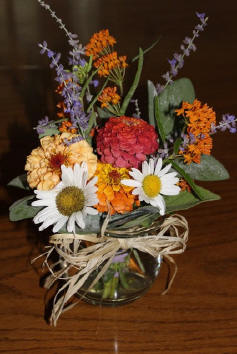(8/15) Our garden club made a summer visit to Beth Thomasson's Herb Farm in Hampton. What a neat place to visit! We enjoyed touring her gardens and shopping in her gift shop , but the highlight for me was making the Tussy Mussy.
She instructed us to first cut a rose or any fairly large, eye-catching flower to serve as the center of the small bouquet, cutting the stems long enough to hold in our hand. Then, taking our time, we searched out and snipped a sprig of this and that, adding the new additions to what we already held in our hand until we were satisfied that our arrangement was complete.
We wrapped ribbon around the stems, tying it in a pretty bow allowing the streamers to hang loosely. So pretty! The tussy mussy can either be easily carried in your hand, or kept in a small vase.
The thought occurred to me that a tussy mussy could make a nice little hostess gift, or a small gift for someone who is celebrating a special occasion, or is ill. I began to read and learn more about tussy mussies and I discovered the whole world of "The Secret Language of Flowers".
 I learned that as early as 1400, flowers, herbs and even trees were associated with certain personality qualities. Through the years, and in different cultures, these beliefs developed and endured. The idea of including them in a small bouquet called a TUSSY MUSSY probably originated during the Elizabethan Age in
sixteenth century England. Lack of sanitation in those times created some terrible odors to be endured by sensitive noses. The small bouquet of strongly scented flowers and herbs carried in the hand could be held to the nose to block some of the offensive smells. It was even believed that they protected the person from the plague and other diseases.
I learned that as early as 1400, flowers, herbs and even trees were associated with certain personality qualities. Through the years, and in different cultures, these beliefs developed and endured. The idea of including them in a small bouquet called a TUSSY MUSSY probably originated during the Elizabethan Age in
sixteenth century England. Lack of sanitation in those times created some terrible odors to be endured by sensitive noses. The small bouquet of strongly scented flowers and herbs carried in the hand could be held to the nose to block some of the offensive smells. It was even believed that they protected the person from the plague and other diseases.
Originally, attractiveness and strong aroma was most likely the primary goal of the bouquet, but during the Victorian era in England during the 1800's, tussy mussies enjoyed a fashionable explosion emphasizing the symbolic meaning of the herbs and flowers. They were used much like we send greeting cards today. Many times a note would be included with the tussy mussy
explaining the secret meaning behind the flowers, but many times the recipient already knew the meanings. Hundreds of books and magazine articles were written on the topic, and tiny booklets were available that a person could carry in one's pocket for instant interpretation.
For instance, red roses say I love you, Lemon Balm expresses sympathy, and Violets are for modesty. Sage stands for wisdom, while zinnias are for goodness, and lavender is devotion.
Not surprisingly, many of the flowers have different and even contradicting meanings attached to them. Basil, for instance, can mean both love and hate, (but usually love) so it is always a good idea to accompany the gift with a small note explaining the intended message!
Today, you can still find many books on the subject listing the meanings of thousands of plants and flowers. I found a long list, by simply googling thelanguageofflowers.com.
The point of this article is to suggest the idea of reviving the custom of using tussy mussies as small gifts. Here are a couple of examples:
A small bouquet of red roses for a wedding anniversary symbolizes love and respect. They are beautiful mixed with some sprigs of lavender which says devotion. Red and white roses together say unity and togetherness. A bunch of daffodils say "The sun is always shining when I am with you." Add some forget-me-nots which stand for true love, and good memories.
You can get off cheap with a big bunch of Dandelions which symbolize Happiness and Faithfulness, but be sure to include a card which explains the meaning with that one!
To welcome a new baby, a white Camellia says, "You are adorable." Bachelor buttons stand for blessedness. Lily of the Valley symbolizes sweetness, and they say, "You've made my life complete."
Got dumped by your girlfriend? Send her some marigolds. They stand for cruelty! Or better yet, Candy Tuft which announces indifference. A yellow carnation says, "You disappoint me."
You can find a flower for almost any sentiment you wish to convey. It's fun and always appreciated by the receiver (except for maybe the dandelions). As a gardener, I can usually go outside and find a number of flowers in any season that will work for the occasion. You can also have the bouquet made up by a florist if you list the flowers you would like to include.
The tussy mussy does not have to symbolize special meanings. It can be anything you want it to be. The pictured Tussy Mussy was one I made up as a small gift for a friend who hosted a garden party, and who is a serious supporter of pollinators. The plants were chosen more because they attract pollinators than for their symbolized meaning.